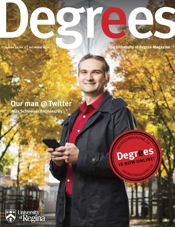Spot Light

John Hampton BFA’09 is a curator, artist, and administrator. They serve as executive director and CEO at the MacKenzie Art Gallery in Regina. A member of the Chickasaw Nation, Hampton is the recipient of the 2017 The Hnatyshyn Foundation – TD Bank Group Award for Emerging Curator of Contemporary Canadian Art, winner of two “Best Exhibition” and one “Curatorial Writing” awards from the Ontario Association of Art Galleries (2014-2016), and was named to ARTINFOS Canada’s 30 under 30. They are the co-chair of the Aboriginal Curatorial Collective board of directors.
- You grew up in Regina. How did your experiences of visiting the MacKenzie as a youngster influence you?
- It has been a journey! I remember one visit as a young child that gave me the impression that the only thing that counted as art was historical landscape painting, and then I also remember a life changing visit to the opening reception for Pow Wow: An Art History. It was the first time I saw a real blend between Indigenous and non-Indigenous communities, it really opened my eyes that maybe these two worlds I know could come together.
- You’re the first Indigenous director of a major Canadian publiclly-funded art gallery. What does that mean to you and why don’t we see more Indigenous directors across the country?
- It's a heavy burden to be the only person in a room, you're expected to hold space for so many diverse perspectives and cultures, when I really just have my own experience as a Chickasaw citizen growing up primarily on Treaty 4 territory. The reason we don't see many Indigenous directors is because of the interconnected pressures of colonization and White supremacy; these institutions were built with an understanding that Western culture is better than every other culture, and we have education, legal, and social systems that reinforce that narrative. There have been recent advancements in changing this view, but these are generational impacts that require seismic changes.
- For those who don’t know, how would you describe the Saskatchewan art scene?
- The Saskatchewan art scene is tight, collaborative, and interdisciplinary. People don't silo themselves in one area like dance, media art, or sound as much as they do in larger centers. Historically Regina was known as a leader in avant garde movements like abstract expressionism, but since the seventies and into today we are better known for Indigenous art, with Saskatchewan connected folks like Adrian Stimson, Lori Blondeau, Joi Arcand, Gerald McMaster, and many more.
- What role does art play in our community?
- Culture is what defines who we are as a community, it is the environment in which we live and grow. Art is the space where we define culture, where we experiment, where we reflect on ideas for how to relate with eachother and see the world. Art is one of those key ingredients of life that keep us going, ignites our passion, and brings life meaning.
- What unique perspectives do you think you bring to your role as executive director and CEO?
- Well I bring my own unique perspective! I'm relatively young, and am unusual for a museum director in the fact that I have such an extensive background in media arts and technology, in my experience as a two-spirit urban Indigenous person, and I also entered the art world as an artist, and try to always bring an artistic sensibility to thinking through how arts institutions can function.
- How would you describe your own art practice?
- Sleeping. I have not made any of my own art since taking on the CEO role; currently all my creative energy is spent on the gallery, but maybe one day again!
- You have implemented an Indigenous Advisory Circle and an Elder program at the MacKenzie. Why?
- The Indigenous Advisory Circle has existed in some manner for over a decade, but its role shifts over time. One of the key roles they play today, is in evaluating my performance through the lens of Indigenous community members, and to call on for advice as we think through new directions for the gallery. Elder Betty McKenna, Elder in Residence, serves on this advisory, but also assists with ceremony, smudging our exhibitions, sharing teachings with staff and management, acting as general cultural counsel in many of our activities and operations.
- What role can galleries play in the Reconciliation process?
- Galleries are caretakers for culture within their respective territory. We have a responsibility to reflect and champion the Indigenous cultures in the territory we sit on; we can help educate audience, support language efforts, exhibit Indigenous artists, hire Indigenous staff and recruit Indigenous board members to help guide the direction of the organization, repatriate any belongings obtained unethically, work with local nations to support their priorities, use our influence to help advance said priorities, and so much more.
- What’s the most satisfying thing about your job with the MacKenzie?
- Hearing of the impact on our visitors! In our recent exhibition examining the construction of White racial identity, we heard many great comments, but one recent visitor comes to mind "I came into the gallery feeling normal on a normal day and am leaving feeling "different" but in a good way," I consider that to be high praise.
- What’s the most fun thing about your job with the MacKenzie?
- Besides my coworkers, who are loads of fun, the most fun aspect is when I get to sneak in on exhibition installations, work with artists, and just generally spending time with art!






